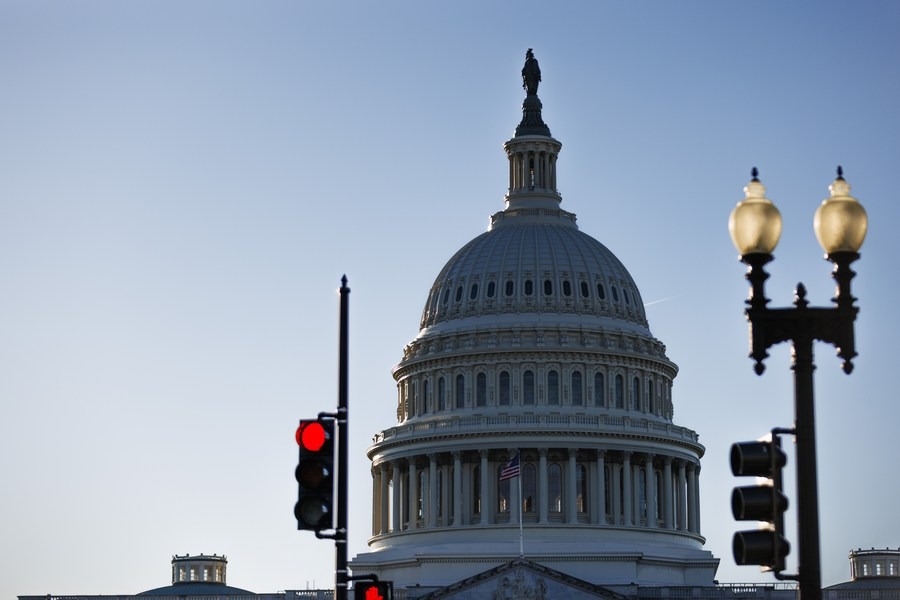Fewer US jobless claims filed

Initial jobless claims fell to 1.54 million last week, or 355,000 fewer than the previous week, the US Labor Department reported Thursday.
Analysts surveyed by Dow Jones expected 1.6 million new jobless claims to be filed.
The unemployment rate fell 0.2 percentage points to 14.4 percent.
The number of new claims has declined for 10 consecutive weeks, suggesting that the worst of the coronavirus-related shock to the economy may be over. However, unemployment remains at a record high.
Workers continuing to receive benefits fell to 20.9 million compared with the 21.5 million a week ago and the peak of 24.9 million the week of May 9.
The four-week moving average fell to 21.9 million, a decline of 404,750 from a week ago, Labor Department statistics showed.
The jobless numbers are key to the debate in Congress about the next coronavirus stimulus bill.
Democrats and Republicans disagree about the need to continue the extra $600 in jobless benefits set to expire July 31.
Democrats say the extra money is needed to help the unemployed meet basic expenses, but Republicans argue that the extra money will discourage people from returning to work and slow the recovery.
"We're slowly seeing the labor market recovery begin to take form," Robert Rosener, an economist at Morgan Stanley, told The New York Times. "But there's still an enormous amount of layoffs going on."
Last week, the Labor Department said the unemployment rate fell to 13.3 percent as companies hired 2.5 million workers. However, a mis-classification in tabulating the statistics pushed the unemployment rate to about 16.4 percent.
The unemployment rate, or the number of unemployed divided by the number of people in the workforce, was 3.5 percent in February before the COVID-19 pandemic hit.
The number of new coronavirus infections is rising in some states. But it's unclear if the new cases reflect a premature re-opening of the economy in those states or if it's the fallout from recent demonstrations and riots to protest the death of an unarmed black man in the custody of Minneapolis police. Many protesters didn't wear masks or observe social distancing guidelines.
According to The Associated Press, Texas reported three consecutive days of record-high coronavirus hospitalization and nine counties in California reported an increase of confirmed cases or hospitalizations.
A study by the National Bureau of Economic Research found "no evidence" that lifting Wisconsin's stay-at-home order "impacted social distancing COVID-19 cases or COVID-19-related mortality" in the following two weeks.
"If we see those numbers coming back in the biggest economy in the world, then that's going to lead to a massive correction," Altaf Kassam, head of investment strategy for State Street Global Advisors in Europe, told The Wall Street Journal.
"Because (Federal Reserve Chairman Jerome) Powell was incredibly dovish, it's finally settled that we're in this for the long haul. We're not going to recovery quickly and there will be pain ahead."
After Wednesday's meeting, the Federal Reserve said it had no plans to boost interest rates through 2022 and vowed to support to the economy battered by the coronavirus pandemic.
The federal funds rate, currently 0-0.25 percent, is the benchmark and affects short-term rates such as interest charged on consumer credit and long-term rates such as mortgages, auto and home equity loans.
The low interest rate is intended to spur investment and consumer spending, which represents about two-thirds of the US economy.
The Fed also pledged to continue to buy Treasury and mortgage-backed securities to stabilize the market.
The Federal Reserve expects the nation's gross domestic product, the value of all goods and services produced in a year, to shrink 6.5 percent in 2020, but to grow 5 percent in 2021 and 3.5 percent in 2022.
The Chicago Board Options Exchange's Volatility Index, a gauge of expected volatility based on S&P 500 options and often called the "fear index", rose to its highest level in about three weeks.
In early trading Thursday, the Dow Jones Industrial Average fell 711.56 points, or 2.60 percent, to 26,278.43. The S&P 500 fell 2.29 percent. The Nasdaq Composite was down 1.97 percent.
On Wednesday, the Dow lost 282.31 points, or 1.04 percent, and closed at 26,989.99. The S&P 500 fell 17.04 points, or 0.53 percent, to 3,190.14. The Nasdaq Composite gained 66.59 points, or 0.67 percent, and closed at 10,020.35.
The technology-heavy Nasdaq has jumped about 45 percent since the market bottomed out in March and crossed the 10,000 mark for the first time during the rally. The index has advanced for eight of the last nine trading days.
Eli Lilly said it may have a coronavirus drug authorized for use by September if either of two antibody therapies now being tested proves effective. The company also has a third antibody treatment in pre-clinical review, Reuters reported. In early trading, Lilly's stock slipped 0.02 percent.
Bank of America Securities boosted it price target for Apple to $390 a share from $340 and maintained its "buy" rating. Analysts cited the company's new 5G iPhone and estimated that hardware sales will grow 20 percent next year. In early trading, Apple fell l.08 percent.
Airline stocks, which had rallied on early signs of an economic rebound, fell in early trading Thursday. American Airlines fell 10.28 percent. Delta Air Lines lost 11.06 percent. Southwest Airlines fell 8.18 percent. United Airlines was down 13.39 percent.
Retail stocks continued decline. Macy's fell 7.62 percent. Kohl's was down 8.18 percent. Home Depot was off 2.24 percent. But Target was down only 0.56 percent.

































